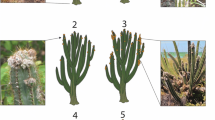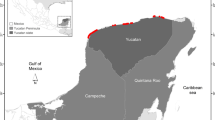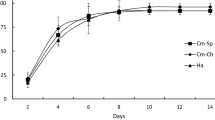Abstract
Cactoblastis cactorum is known for being both a biological control agent and an invasive pest of opuntioid cacti. The spread of C. cactorum in the southeastern United States may threaten the biological and physical integrity of desert, scrub, and coastal habitats. However, the effects of invasive species are known to vary spatially and temporally, and C. cactorum’s efficacy as a biological control agent varies considerably from region to region. Therefore, the long term effects of C. cactorum within its U.S. range are still uncertain. Marked Opuntia stricta (n = 253) and O. humifusa (n = 327) plants along the west coast of Florida were censused for 6 years to determine the effects of C. cactorum attack on survival and growth rate of plants, and to examine host species differences and the effects of plant size. 78.1 % of the Opuntia plants were attacked by C. cactorum during the 6 year study and the overall survival rate was 75.8 %. Plants attacked by C. cactorum were more likely to die than unattacked plants and a plant’s odds of surviving the 6 year period decreased as C. cactorum attack frequency increased. However, plants that survived the 6 year period showed, on average, positive growth and there was no significant difference in growth rates between surviving attacked and unattacked plants. O. stricta plants were more likely to be attacked at least once, were attacked more frequently, and were more likely to die after being attacked than were O. humifusa plants. Plant size did not predict plant survival, but larger surviving plants lost proportionally more pads over the 6 years than smaller surviving plants. Although C. cactorum should still be considered a threat, particularly for rare opuntioids, overall survival along the west central Florida coast is currently high and plants that are able to survive C. cactorum attack are not being reduced in size, possibly because they possess traits that render them more tolerant of C. cactorum damage. Our findings suggest that an assumption of severe negative effects of an invasive species, based on its effects in other regions or over short periods of time, may not always be justified.




Similar content being viewed by others
References
Baker AJ, Stiling P (2009) Comparing the effects of the exotic cactus-feeding moth, Cactoblastis cactorum (Berg) (Lepidoptera: Pyralidae), and the native cactus-feeding moth, Melitara prodenialis (Walker) (Lepidoptera: Pyralidae), on two species of Florida Opuntia. Biol Invasions 11:619–624
Bennett FD, Simmonds FJ (1966) Biological control of Opuntia spp. by Cactoblastis cactorum in the Leeward Islands (West Indies). Biocontrol 11:183–189
Brown JH, Sax DF (2004) An essay on some topics concerning invasive species. Aust Ecol 29:530–536
Brown JH, Sax DF (2005) Biological invasions and scientific objectivity: reply to Cassey et al. (2005). Aust Ecol 30:481–483
Brown JH, Sax DF, Simberloff D, Sagoff M (2007) Aliens among us. Conserv Mag 8:14–21
Cassey P, Blackburn TM, Duncan RP, Chown SL (2005) Concerning invasive species: reply to Brown and Sax. Aust Ecol 30:475–480
Colautti RI, MacIsaac HJ (2004) A neutral terminology to define ‘invasive’ species. Divers Distrib 10:135–141
Davis M, Chew MK, Hobbs RJ, Lugo AE, Ewel JJ, Vermeij GJ, Brown JH, Rosenzweig ML, Gardener MR, Carroll SP, Thompson K, Pickett STA, Stromberg JC, Del Tredici P, Suding KN, Ehrenfeld JG, Grime JP, Mascaro J, Briggs JC (2011) Don’t judge species on their origins. Nature 474:153–154
Denslow JS, D’Antonio CM (2005) After biocontrol: assessing indirect effects of insect releases. Biol Control 35:307–318
Dodd AP (1940) The biological campaign against prickly pear. Commonwealth Prickly Pear Board Bulletin, pp 1–177
Gibson AC, Nobel PS (1986) The Cactus Primer. First Harvard University Press, Cambridge
Hager HA, McCoy KD (1998) The implications of accepting untested hypotheses: a review of the effects of purple loosestrife (Lythrum salicaria) in North America. Biodivers Conserv 7:1069–1079
Hight SD, Carpenter JE (2009) Flight phenology of male Cactoblastis cactorum (Lepidoptera: Pyralidae) at different latitudes in the Southeastern United States. Fla Entomol 92:208–216
Hoffmann JH, Moran VC, Zeller DA (1998) Evaluation of Cactoblastis cactorum (Lepidoptera: Phycitidae) as a biological control agent of Opuntia stricta (Cactaceae) in the Kruger National Park, South Africa. Biol Control 12:20–24
Hoffmann JH, Moran VC, Zimmermann H (1999) Integrated management of Opuntia stricta (Haworth) Haworth (Cactaceae) in South Africa: an enhanced role for two, renowned, insect agents. In: Olckers T, Hill MP (eds) Biological control of weeds in South Africa (1990–1998). African Entomology Memoir no 1, pp 15–20
Holway DA, Suarez AV, Case TJ (2002) Role of abiotic factors in governing susceptibility to invasion: a test with argentine ants. Ecology 83:1610–1619
Hosking JR, Sullivan PR, Welsby SM (1994) Biological control of Opuntia stricta (Haw) Haw var. stricta using Dactylopius opuntiae (Cockerell) in an area of New South Wales, Australia, where Cactoblastis cactorum (Berg) is not a successful biological control agent. Agric Ecosyst Environ 48:241–255
Jezorek HA, Stiling PD, Carpenter JE (2010) Targets of an invasive species: oviposition preference and larval performance of Cactoblastis cactorum (Lepidoptera: Pyralidae) on 14 North American opuntioid cacti. Environ Entomol 39:1884–1892
Johnson DM, Stiling PD (1996) Host specificity of Cactoblastis cactorum (Lepidoptera: Pyralidae), an exotic Opuntia-feeding moth, in Florida. Environ Entomol 25:743–748
Johnson DM, Stiling PD (1998) Distribution and dispersal of Cactoblastis cactorum (Lepidoptera: Pyralidae), an exotic Opuntia-feeding moth, in Florida. Fla Entomol 81:12–22
Kenis M, Auger-Rozenberg MA, Roques A, Timms L, Pere C, Cock M, Settele J, Augustin S, Lopez-Vaamonde C (2009) Ecological effects of invasive alien insects. Biol Invasions 11:21–45
Larson BMH (2007) An alien approach to invasive species: objectivity and society in invasion biology. Biol Invasions 9:947–956
Mack RN, Simberloff D, Lonsdale WM, Evans H, Clout M, Bazzaz FA (2000) Biotic invasions: causes, epidemiology, global consequences, and control. Ecol Appl 10:689–710
McFadyen REC (1998) Biological control of weeds. Annu Rev Entomol 43:369–393
Monro JM (1975) Environmental variation and the efficiency of biological control—Cactoblastis in the southern hemisphere. In: Kikkawa J, Nix Ha (eds) Proceedings of the Ecological Society of Australia (vol 9). Managing terrestrial ecosystems. Symposium. Brisbane, Aust., 15–16 May 1975. Vi+335p. Illus. Ecological Society of Australia, Canberra, Australia. ISBN 0-909436-02-9. pp 204–212
Morrison LW (2002) Long-term impacts of an arthropod-community invasion by the imported fire ant, Solenopsis invicta. Ecology 83:2337–2345
Morrison LW, Porter SD (2003) Positive association between densities of the red imported fire ant, Solenopsis invicta (Hymenoptera: Formicidae), and generalized ant and arthropod diversity. Environ Entomol 32:548–554
Niemela J, Spence JR (1991) Distribution and abundance of an exotic ground beetle (Carabidae)—a test of community impact. Oikos 62:351–359
Parker IM, Simberloff D, Lonsdale WM, Goodell K, Wonham M, Kareiva PM, Williamson MH, Von Holle B, Moyle PB, Byers JE, Goldwasser L (1999) Impact: toward a framework for understanding the ecological effects of invaders. Biol Invasions 1:3–19
Pemberton RW, Liu H (2007) Control and persistence of native Opuntia on Nevis and St. Kitts 50 years after the introduction of Cactoblastis cactorum. Biol Control 41:272–282
Pettey FW (1948) The biological control of prickly pear in South Africa. Science Bulletin. Department of Agriculture of the Union of South Africa
Phillips CB, Baird DB (2001) Geographic variation in egg load of Microctonus hyperodae loan (Hymenoptera: Braconidae) and its implications for biological control success. Biocontrol Sci Technol 11:371–380
Pintor LM, Sih A (2011) Scale dependent effects of native prey diversity, prey biomass and natural disturbance on the invasion success of an exotic predator. Biol Invasions 13:1357–1366
Porter SD, Savignano DA (1990) Invasion of polygene fire ants decimates native ants and disrupts arthropod community. Ecology 71:2095–2106
Robertson HG, Hoffmann JH (1989) Mortality and life-tables of Cactoblastis cactorum (Berg) (Lepidoptera: Pyralidae) compared on 2 host-plant species. Bull Entomol Res 79:7–17
Romeis J, Babendreier D, Wackers FL, Shanower TG (2005) Habitat and plant specificity of Trichogramma egg parasitoids—underlying mechanisms and implications. Basic Appl Ecol 6:215–236
Rose R, Weeks R, Usnick S (2011) Cactus Moth, Cactoblastis cactorum, 2011 survey plan for PPQ and state cooperators. United States Department of Agriculture, Animal and Plant Health Inspection Service
Sagoff M (2005) Do non-native species threaten the natural environment? J Agric Environ Ethics 18:215–236
Schlaepfer MA, Pascal M, Davis MA (2011) How might science misdirect policy? Insights into the threats and consequences of invasive species. J Verbrauch Lebensm 6:27–31
Shea K, Kelly D, Sheppard AW, Woodburn TL (2005) Context-dependent biological control of an invasive thistle. Ecology 86:3174–3181
Simberloff D (2005) Non-native species do threaten the natural environment! J Agric Environ Ethics 18:595–607
Snyder WE, Evans EW (2006) Ecological effects of invasive arthropod generalist predators. Annu Rev Ecol Evol Syst 37:95–122
Stiling P (2010) Death and decline of a rare cactus in Florida. Castanea 75:190–197
Strauss SY (1988) Determining the effects of herbivory using naturally damaged plants. Ecology 69:1628–1630
Strayer DL, Eviner VT, Jeschke JM, Pace ML (2006) Understanding the long-term effects of species invasions. Trends Ecol Evol 21:645–651
White GC (1980) Current status of prickly pear control by Cactoblastis catorum in Queensland. In: Proceedings of the Vth international symposium on biological control of weeds, Brisbane, Australia, pp 609–616
Wilson KA, Magnuson JJ, Lodge DM, Hill AM, Kratz TK, Perry WL, Willis TV (2004) A long-term rusty crayfish (Orconectes rusticus) invasion: dispersal patterns and community change in a north temperate lake. Can J Fish Aquat Sci 61:2255–2266
Zimmermann HG, Moran VC, Hoffmann JH (2000) The renowned Cactus Moth, Cactoblastis cactorum (Lepidoptera: Pyralidae): its natural history and threat to native Opuntia floras in Mexico and the United States of America. Fla Entomol 84:543–551
Zimmermann HG, Bloem S, Klein H (2004) Biology, history, threat, surveillance and control of the Cactus Moth, Cactoblastis cactorum. International Atomic Energy Agency/Food and Agriculture Organization, Vienna
Acknowledgments
We would like to thank Debi Tharp and Kerry Bohl for their enormous contribution to data collection, Terry Hingtgen (Florida Department of Environmental Protection, Southwest Division) for his assistance in acquiring the necessary permits for field work at Honeymoon Island State Park, and the employees of Fort deSoto County Park and Lido Key beaches for their support during the course of the study.
Author information
Authors and Affiliations
Corresponding author
Rights and permissions
About this article
Cite this article
Jezorek, H., Baker, A.J. & Stiling, P. Effects of Cactoblastis cactorum on the survival and growth of North American Opuntia . Biol Invasions 14, 2355–2367 (2012). https://doi.org/10.1007/s10530-012-0234-9
Received:
Accepted:
Published:
Issue Date:
DOI: https://doi.org/10.1007/s10530-012-0234-9




